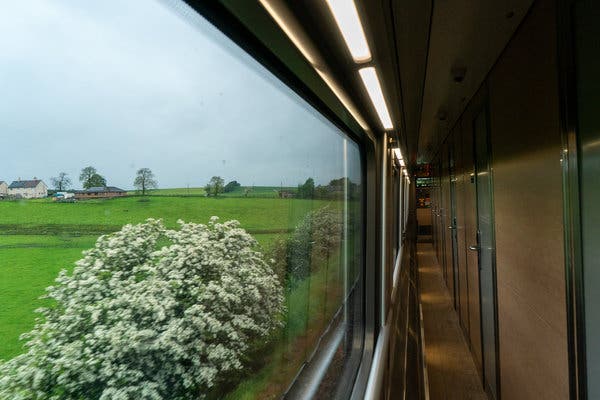
A fancy overnight train, an abundance of street art and an excursion to the highlands bring the Scottish city of Aberdeen to life.CreditCreditSebastian Modak/The New York Times
Our columnist, Sebastian Modak, is visiting each destination on our 52 Places to Go in 2019 list. He was on the Frisian Island of Texel before getting on the train to Aberdeen, Scotland.
I was having breakfast in a sun-dappled corner of Books and Beans, a used bookstore and cafe in Aberdeen, Scotland, when I got the message on my phone.
“Where are you right now? There’s a wizard who has got a present for you,” wrote Jon Reid, a street art organizer I had met a few days earlier.
I looked around confused, half expecting a robed figure to hop out of one of the bookshelves filled with fantasy paperbacks. Twenty minutes passed and I finished my coffee and croissant. Then, an imposing figure approached holding his phone with a photo of me pulled up on the screen.
“I’m Steve,” said the wizard, smiling through a thick salt-and-pepper beard and extending an arm covered in tattoos for a handshake. “I hear you like cats, too.”
Within 10 minutes the wizard, Steve Murison, was gone, but, as promised, he had left me with a present: Two paintings on six-by-nine-inch scraps of cardboard, each an abstract depiction of a cat, with snippets of found grocery lists pasted onto them. On the back of each piece was a hashtag, #catsoftheromanempire. Like any wizard worth his salt, he had given me a task: to take them on my journey and leave them elsewhere in the world for someone to pick up.

CreditSebastian Modak/The New York Times
The Golden Age of train travel — with some bumps along the way
The conjuration of Steve and his cats wasn’t my first surprising moment in Aberdeen. The city is not known for art. Most travelers to Scotland would choose Edinburgh or Glasgow if that’s what they were looking for. Instead, Aberdeen’s reputation is centered on offshore oil exploration and the color gray, thanks to its ubiquitous granite buildings. But where others might see its monochrome aesthetic and industrial aura as a downer, the city is crawling with artists who see it as an opportunity — to not only imbue Aberdeen with color and light, but also to change its reputation.
Though I found unbridled creative energy and artists who welcomed me into their fold, Aberdeen was on my itinerary for another reason: The novelty of overnight train travel in the form of the newly outfitted Caledonian Sleeper, which connects London’s Euston station with a number of cities in Scotland, including Aberdeen. I arrived in London right in the middle of the company’s roll-out of its new trains, happening through the summer. It was not going smoothly.
[Europe’s overnight trains, which seemed to be disappearing, are on the rebound.]
Approaching my train, I was greeted by an attendant who told me my plans had changed. A power failure in the train car I had reserved meant there “was no space” for me on the Highlander to Aberdeen. I’d been rebooked on the Lowlander, a shorter trip leaving two hours later, to Edinburgh where I’d connect to a local train to Aberdeen. The silver lining: I’d be on a new sleeper car, instead of “this old clunker,” as the attendant described the train waiting behind me.
I wasn’t the only one getting surprised. A pair of friends I met who had booked tickets a year in advance had been inexplicably downgraded to a cabin without an attached bathroom. Staff on the train told me these issues were part of the gradual transition to new trains and should be smoothed out once it was complete.
That was good to hear, because the trip itself was lovely. The new train, outfitted with sleek, modern furnishings, makes for the kind of slow travel that is increasingly rare. I started my evening in the Club Car, a collection of booths and window-facing seats, where you can order from a menu that includes nine Scottish whiskies. With nothing to do, nowhere to be and, because of the train’s departure long after nightfall, nothing to really see, entertainment for a solo traveler like myself came from talking to other travelers. That’s how I ended up walking back to my cabin, at 2:30 in the morning.
Four hours later, I woke up in my surprisingly comfortable bunk, the bright green blur of the Scottish countryside on display through my window. There was just enough time for a “Highlander Breakfast” — haggis, sausage, eggs — before making my connection in Edinburgh for Aberdeen.
Once you see it
“I think this year has been the tipping point,” Jon Reid said. “People really love all the art and now think of it as part of the city.”
Mr. Reid had just finished leading a free street art tour of the city and we were sitting in a plaza, sipping coffee and looking up at a mural depicting a young girl splashed across the facade of the Aberdeen Market by the German duo Herakut.
“This building, for example, has long been thought of as an eyesore,” he said, pointing at the vaguely dystopian circular chunk of concrete. “Now the city’s talking about tearing it down to build some shiny glass tower and I wouldn’t be surprised if Aberdonians came out to save it to preserve the art.”
Mr. Reid, an artist himself, works with Nuart Aberdeen, an offshoot of an organization that started in Stavanger, Norway (where I, coincidentally, had been just a few weeks before). The parallels are clear — two oil cities that, as Mr. Reid described it, “were long deprived of culture.” While Stavanger certainly had a head start and is now considered a destination for street art aficionados, the pace at which the scene has grown in Aberdeen is astounding. That’s in large part because of the annual Nuart Aberdeen Festival, which began in 2017 and brings in artists from all over the world to take over the walls of the city.
A city ordinance prohibits street artists from painting on any of the granite buildings for the sake of historic preservation, but in the city center, it can feel like every other available space has been claimed. There are the big statements, like a towering piece of two figures embracing while also pushing each other away, an interpretation by the Argentine artist known as Hyuro of the complicated relationship between England and Scotland. Nearby, there’s a photorealistic portrait by Smug, a Glasgow-based artist, of his barber, facial tattoos on full display and with a bowtie-wearing puppy in his lap — an invitation for viewers to challenge their snap judgments of people.
Then there are the little details, cheeky takes scattered throughout the city. Once you notice one of the pieces by EVOL, a Berlin-based artist, you see them everywhere: electric boxes painted to resemble Aberdeen’s public housing projects.
“For big street art cities like Stavanger, history has been painted onto the walls,” Mr. Reid said. “For Aberdeen, it’s a new history that’s being written right now.”
Street art in Aberdeen, at least the kind sanctioned by the city, only really took off in the last few years. That is thanks, in part, to Jon Reid’s partner, the painter Mary Louise Butterworth who was one of the coordinators of the Painted Doors project, started in 2016, which transformed the drab doors of the city’s warehouses and office buildings into works of art.
Other Aberdeen spots I loved:
-
There are plenty of whisky distilleries within driving distance of Aberdeen, each offering tours and tastings. But for a primer head to The Grill, a 150-year-old pub that has a selection of 600 — yes, six hundred — Scottish whiskies. A drink list like that can be intimidating, but the people behind the bar were more than happy to walk me through my options. Talk to them long enough and they’ll also regale you with stories from the bar’s past — like the time in 1973 when women attending a trade union conference across the street stormed the bar, which at that point served only men, demanding to be served. (Two years later it began officially serving women.)
-
The best meal I had in Aberdeen was at Moonfish Cafe, where the seasonally rotating menu is built on locally sourced beef and seafood. Despite the level of culinary innovation and beautiful presentation, prices are very reasonable, likely a product of the city’s widespread disdain for over-the-top pomposity.
But it’s not just public art that betrays Aberdeen’s gray, industrial reputation. Through Mr. Reid and Ms. Butterworth, I met other creatives who are quietly working to change the city. I visited the Nigerian-born artist Ade Adesina, whose massive linocut prints juxtapose Edenic natural scenes with the heavy footprint of industries like Aberdeen’s own offshore oil rigs. When I met him, he was in the midst of preparing for an exhibition in Edinburgh, a logistical nightmare when it comes to transporting such big pieces. When I asked why he didn’t just move down there, a place famous for its arts scene, his answer was simple.
“There are no distractions here,” he said. “I can’t have people constantly knocking on my door when I’m trying to work.”
Mr. Adesina does his printing at Peacock Visual Arts, hidden down a narrow lane. The nonprofit printmaking studio works with luminaries like Ralph Steadman and university students alike. It didn’t take me long to realize that though Aberdeen’s art community is small, any inferiority complex brought about by the lack of attention it gets compared to bigger Scottish cities is outweighed by the solidarity and sense of community felt by its artists.
A haven for day-trippers
Those artists became my clique during my brief stay in Aberdeen and together we ventured out to Stonehaven, a charming seaside town just a 40-minute drive south of the city center. There, we queued up at The Bay for what Mr. Reid described as the best fish and chips in the U.K. (it was very, very good). On the village’s outskirts is Dunnottar Castle, a 15th-century castle complex perched on a green hilltop overlooking the perpetually furious North Sea.
Further west we visited Royal Lochnagar, one of the many whisky distilleries that fill the countryside and continued on to the sweeping plains around Loch Muick, where herds of deer watched us warily from afar. Nearby is the village of Ballater, just eight miles from Balmoral Castle, the British Royal Family’s preferred country retreat.
Aberdeen transitions from city — gray on gray on gray — to lush green countryside so quickly, it’s no wonder that so many artists find inspiration there. The hikes and drives that make Scotland such a popular destination are so easily accessible and when you come home at the end of the day, you’re in a place that feels manageable. The only time I stepped into a taxi was to get to the airport on my way out of the city.
A lot of Aberdonians know the city is special, even as many artists bemoaned the self-deprecation that pervades northern Scotland.
“My ideology has always been that if you’re not pushing and not fighting to make the things you want to see happen, then you can’t complain about them not happening,” said Mr. Reid, who traces his own involvement to an arts blog he started in 2008. “You can’t do nothing and expect everything.”
It’s remarkable how meeting a handful of doers can completely transform the experience of a place. Now, I’ve got some cats to disperse into the world.







